
In Antiquity
In the Middle Ages
Near Outlying Areas
The Monastery of the Mother of God of Blachernai
Monastery in Sarandinakina balka
Zefir-Koba monastery
Monastic complex at cape Vinogradnyy
Caves near Skala Svyatogo Yavleniya
Fortress of Cembalo
Cave town of Kalamita or Inkerman
Syuyren' fortress
Monastery on the island in Kazach'ya bay
Far Outlying Areas
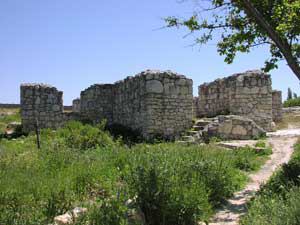
The ruins of this monastery are located in the necropolis of Chersonesos, outside the city walls, in the Karantinnaya (Russian for "quarantine") ravine. Take the trolleybus no. 6 or 10 till the "Ulitsa Galiny Petrovoy" (Galina Petrova Street) stop, then go through the yard of the building college, and descend to the ravine.
This complex, located in the necropolis outside the city walls of Chersonesos, was discovered in 1902 in course of K.K. Kostsyushko-Valyuzhinich's excavations; supplementary investigations were organized in 1953 by Oleg Dombrovskiy. This monastery is known in scholarship under the name of the Mother of God of Blachernai. The stone monastery fence encircled Christian graves, chasovnya (small building for Orthodox worship without an altar, where no liturgy was allowed), large cross church, and several rooms which could be used for living or economic needs.
| This church outside the city walls was erected in the 10th century (some scholars hypothesized another date, the 6th century) and is distinguished because of its well-preserved walls, up to 3 m high. Although the scholars express different opinions regarding this church chronology, they all relate the church with the memory of the Roman pope St. Martin the Confessor. | 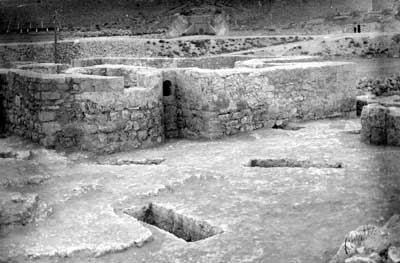 |
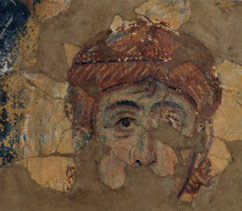 Fragment of fresco paintings from the church: head of unknown saint |
According to his Life, pope Martin was sentenced to death because of false accusation of presumable "betrayal of the emperor". But the emperor had mercy on him, and the pope spent few month in prison and, on March of 655, was finally exiled to Chersonesos, where he died and was buried "within the necropolis of saints", in the "beautiful house of the Virgin Mary, called of Blachernai, outside the walls, one stadium far from the blessed city of Cherson". The described complex outside the walls of Cherson with its richly adorned church meets the above words in the best way possible. |
The fact that this monastery remained the center of pilgrimage for a long time, to the 16th century, testifies to its memorial nature. It is important to note that some Christian devotees, who remain unknown to us, were probably buried on the site long before St. pope Martin's funeral: not without a reason was this place called "the necropolis of saints". In some scholars' point of view, these could be the first bishops-missionaries to Chersonesos.

Aerial view of the church and necropolis
| The church outside the city walls was one of the first archaeological objects that was exposed to thorough restoration and displayed under a light roofing. The state treasury offered money to support watchmen on the site. That is the image showing how the church looked like in the early 20th century. | 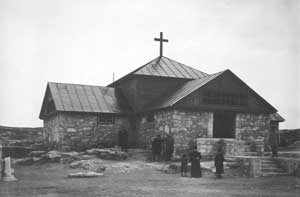 |
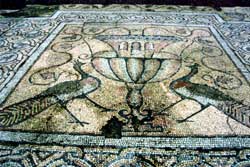 |
The central section of the mosaic composition contains symbols of the Eucharist: kantharos with two peacocks, and two grapevines growing from the kantharos, upon which pigeons seat. All the rest space of the mosaics is filled with medallions featuring birds, fruits, and flowering branches, "borrowed from the vegetable and animal kingdoms." |
In 1953, the mosaic floors were taken away from the place and transported to the museum of Chersonesos (in order to preserve them), and in 1972-1973 were placed at the museum courtyard. In 2004, the floors were removed to make a new but necessary conservation.